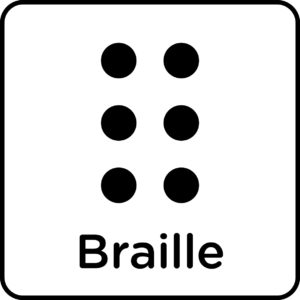Many people often conflate ADA regulations and ADA signage with signs that simply need Braille, and though it’s just a small component of ADA signage we did feel it important enough to take a moment to delve into Braille, its history, and how and when it is needed in ADA signage.
History of Braille
Braille is forever linked with Louis Braille, the young Frenchman who in his teens began to adapt a six-dot code for writing and music notation. According to Britannica.com, after being blinded at the age of 3, Braille, a rather incredible student in his outright, invented the system at the age of 15. Braille was not working in a vacuum however when he developed his system, as he adapted his own method from work by Charles Barbier. Likewise Valentin Haüy, a fellow Frenchman, years before had developed a system of embossed paper for use of reading by the blind. Hauy is also known as the founder of Institut National des Jeunes Aveugles (National Institute for Blind Children), where Louis Braille was a student and first developed Braille.
The Adoption of Braille
Braille was adopted over time by educators and countries alike, and in 1932 representatives of the United Kingdom and the United States of America met to adopt the system known as English Standard Braille.
Simple Introduction to Braille

By Padin – Own work, CC BY-SA 2.5 es, https://commons.wikimedia.org/w/index.php?curid=120922892
Despite popular belief Braille itself is not a language. Instead Braille uses a system of 63 dot patterns with 2 columns and 3 rows where dots can be placed. The different patterns of dots vary to identify different numbers, letters, punctuation marks, attributes, and more.
Two Types of Braille
According to Perkins School for the Blind, there are two types of braille: contracted and uncontracted.
“In uncontracted braille, every word is spelled out. Contracted braille is a “shorthand” version where common words are abbreviated, much like “don’t” is a shorter version of “do” and “not.” Most children learn uncontracted braille before they learn the contracted version.”
Braille and ADA
In 1990, The Americans with Disabilities Act passed in Congress and was signed into law. This act helped codify federal requirements to help increase access to all persons in public buildings.
Among the regulations in the act are those identifying the use of Braille, including when it should be used, where it should be placed, as well as the proper use.
What Type of Signs Incorporate Braille?
Braille signs fall under the heading of Tactile Signage.
According to the International Sign Association, a tactile sign is “a sign, or an area within a larger sign or area, which conveys its message through raised or engraved artwork, making it accessible to the visually impaired. Required by A.D.A. for all permanently identified rooms.”
Where must Braille appear on ADA Compliant Signs?
According to Access-Board.Gov, Braille is located below raised characters, including when text is multi-lined.
What specifications must be met for the Braille to be ADA Compliant?
According to Access-Board.gov, “Braille dots shall have a domed or rounded shape and shall comply with Table 703.3.1. The indication of an uppercase letter or letters shall only be used before the first word of sentences, proper nouns and names, individual letters of the alphabet, initials, and acronyms.
Braille shall be positioned below the corresponding text. If text is multi-lined, braille shall be placed below the entire text. Braille shall be separated 3/8 inch (9.5 mm) minimum from any other tactile characters and 3/8 inch (9.5 mm) minimum from raised borders and decorative elements.
EXCEPTION: Braille provided on elevator car controls shall be separated 3/16 inch (4.8 mm) minimum and shall be located either directly below or adjacent to the corresponding raised characters or symbols.”




















![[Total Number of ADA Title III Federal Lawsuits Filed Each Year January 1, 2013 – December 31, 2021: 2013: 2,722; 2014: 4,436 63% increase over 2013; 2015: 4,789 8% increase over 2014; 2016: 6,601 38% increase over 2015; 2017: 7,663 16% increase over 2016; 2018: 10,163 33% increase over 2017; 2019: 11, 053 9% increase over 2018; 2020: 10,982 1% decrease from 2019]](https://www.adatitleiii.com/wp-content/uploads/sites/121/2021/02/Yearly.png)